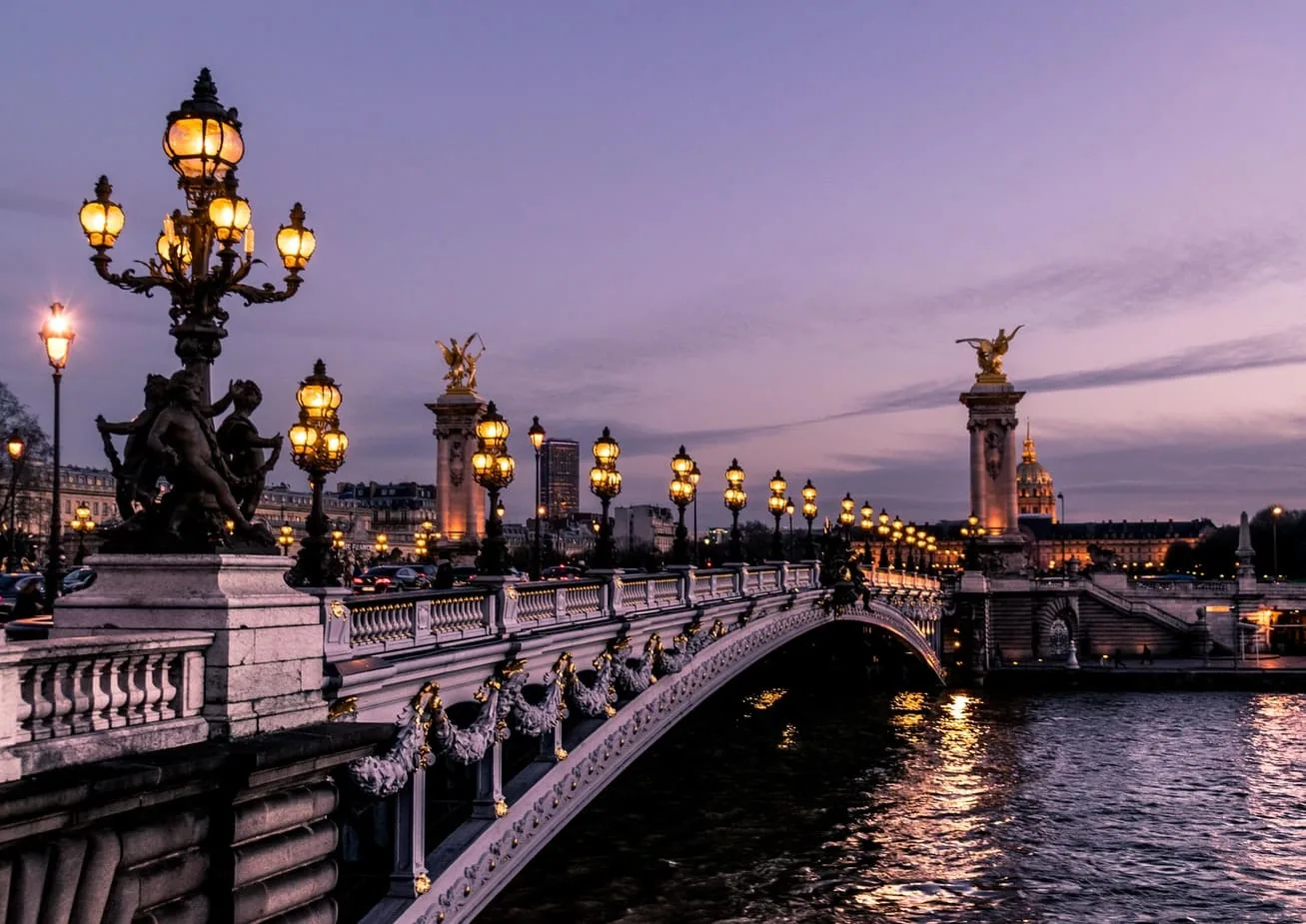Expert travel storyteller Jordan Adkins, founder of InspiredByMaps.com, brings a decade of adventures across 101 countries and 450+ UNESCO sites into rich, off-the-beaten-path narratives, melding ecological expertise with genuine, seasoned travel insights. His full bio can be found here.
France is well known for its extraordinary natural diversity, vibrant culture, and remarkable urban landscapes. Fittingly, France is also home to 45 of the more than 1,000 World Heritage Sites worldwide, as inscribed by the United Nations Educational, Scientific, and Cultural Organization (UNESCO).
France’s captivating UNESCO sites include magnanimous cathedrals, extensive national parks, and geological wonders. These sites range from the iconic Palace and Park of Versailles and the spectacular medieval town of Provins to the far-flung Lagoons of New Caledonia and iconic Pyrénées.
The theme of culture is prevalent throughout these eight sites. However, there are also important natural and mixed sites that reflect France’s remarkable natural heritage. Some of these sites are landmarks of France, but a few are rather obscure and likely only known to the most persistent of travelers.
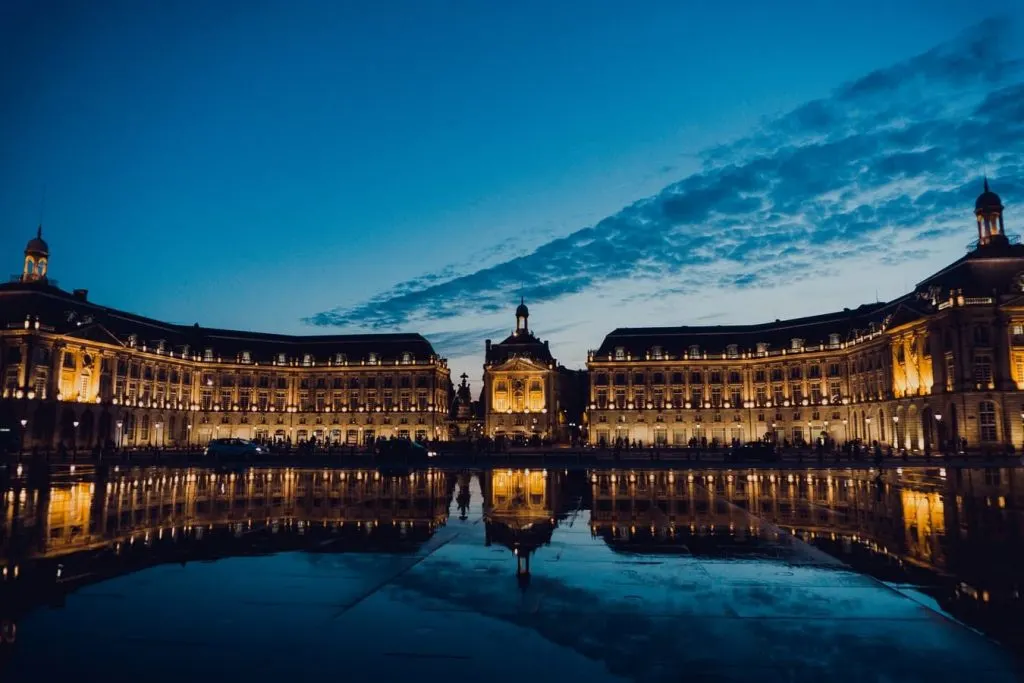
UNESCO is a bureau of the United Nations that endeavors to support the protection and growth of the world’s intellectual and cultural property and elects UNESCO sites due to their “outstanding universal value” in science, history, or culture. As a result, UNESCO Sites are meaningful to the mutual interests of humanity – and legally guarded by international treaties.
Travel influenced by UNESCO sites allows visitors to explore esoteric spots, aid preservation, obtain specific knowledge about the history of Earth and humanity – and to wonder at unequivocally majestic sites. While a few such as the marvelous landscape of Rio de Janeiro and the Singapore Botanical Gardens are famous around the world, there are far more untouristy UNESCO sites worthy of insertion in any ‘off-the-beaten-track’ bucket list.
Inscriptions settle into two categories: cultural and natural locations, or a combination of both (mixed). There are currently 45 UNESCO world heritage sites in France, 39 cultural ones, five natural ones, and one mixed. While I have visited most of them myself, I have included all sites here – so you can get an idea of what makes each special.
So, why not immerse yourself in one or more of these sites on your next France vacation? From breathtaking natural wonders to unprecedented feats of human engineering, check out our exhaustive list of France UNESCO sites to determine which places resonate with you personally. You can then use them as a roadmap for the trip of a lifetime.
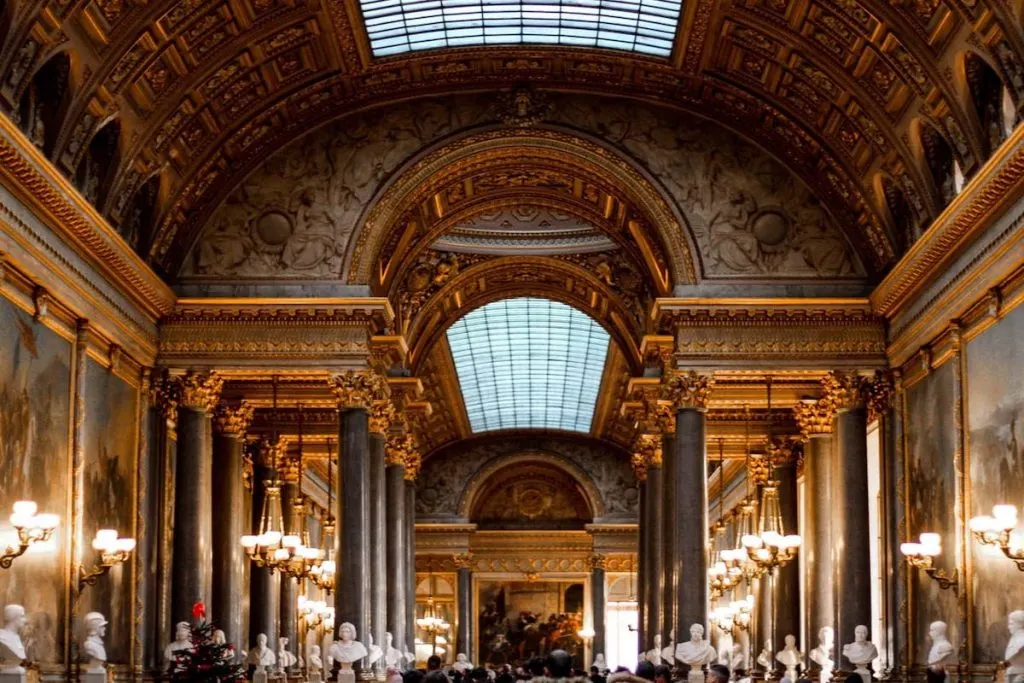
Page Contents
- Cultural UNESCO World Heritage Sites In France
- Abbey Church of Saint-Savin sur Gartempe
- Amiens Cathedral
- Arles, Roman and Romanesque Monuments
- Belfries of Belgium and France
- Bordeaux, Port of the Moon
- Bourges Cathedral
- Canal du Midi
- Cathedral of Notre-Dame, Former Abbey of Saint-Rémi and Palace of Tau, Reims
- Champagne Hillsides, Houses and Cellars
- Chartres Cathedral
- Cistercian Abbey of Fontenay
- Decorated Cave of Pont d’Arc, known as Grotte Chauvet-Pont d’Arc, Ardèche
- Episcopal City of Albi
- Fortifications of Vauban
- From the Great Saltworks of Salins-les-Bains to the Royal Saltworks of Arc-et-Senans, the Production of Open-pan Salt
- Historic Centre of Avignon: Papal Palace, Episcopal Ensemble and Avignon Bridge
- Historic Fortified City of Carcassonne
- Historic Site of Lyon
- Jurisdiction of Saint-Emilion
- Le Havre, the City Rebuilt by Auguste Perret
- Mont-Saint-Michel and its Bay
- Nord-Pas de Calais Mining Basin
- Palace and Park of Fontainebleau
- Palace and Park of Versailles
- Paris, Banks of the Seine
- Place Stanislas, Place de la Carrière and Place d’Alliance in Nancy
- Pont du Gard (Roman Aqueduct)
- Prehistoric Pile Dwellings around the Alps
- Prehistoric Sites and Decorated Caves of the Vézère Valley
- Provins, Town of Medieval Fairs
- Roman Theatre and its Surroundings and the “Triumphal Arch” of Orange
- Routes of Santiago de Compostela in France
- Strasbourg, Grande-Île and Neustadt
- Taputapuātea
- The Architectural Work of Le Corbusier, an Outstanding Contribution to the Modern Movement
- The Causses and the Cévennes, Mediterranean agro-pastoral Cultural Landscape
- The Climats, terroirs of Burgundy
- The Loire Valley between Sully-sur-Loire and Chalonnes
- Vézelay, Church and Hill
- Natural UNESCO World Heritage Sites In France
- Mixed UNESCO World Heritage Sites In France
Cultural UNESCO World Heritage Sites In France
Abbey Church of Saint-Savin sur Gartempe
Positioned in the Nouvelle-Aquitaine region of France, the Abbey Church of Saint-Savin-sur-Gartempe is an ancient abbey refounded under the safeguard of Charlemagne in the mid-11th century.
It is principally protected as France’s world heritage because of the many impressive 11th- and 12th-century murals that are preserved here and depict biblical scenes. The most well-known painting is Noah’s Ark, where a packed wooden boat is composed of pairs of animals along with a few humans . in front of the windows and several human passengers at the top deck. This mural decoration makes this structure a rare testimony to medieval tradition when churches were painted, which is not often seen.
It reminded me of the UNESCO Churches of Moldavia in Romania, which are painted – but outside! The Abbey Church of Saint-Savin sur Gartempe is protected because of its murals. Still, there is also a monk’s quarters and museum to explore.
Amiens Cathedral
Amiens Cathedral is one of the largest churches in France. Unlike some other Gothic cathedrals of the 13th century, Amiens Cathedral is the most complete one. The sculptures and the stained glass windows make it stand apart from the rest. That is why it is protected as a UNESCO World Heritage.
There are so many details worth observing inside the cathedral; it can easily take more than an hour to tour the interior. The Amiens Cathedral organ at the back of the Cathedral high over the door looks grand even today. Visit on a Sunday to hear it being played during the mass. The Baroque pulpit is supported by three figures Charity, Faith, and Hope, beautifully chiseled out of marble and wood shrouded in gold.
Many Biblical stories are told through the facade sculptures as well as through those sculptures and paintings inside the cathedral. I particularly liked the three-door arches on the western façade. They are infused with sculptures of angels and Christ on His throne with statues of Virgin and Saint John on either side.
Location: Amiens is 161km north of Paris. It is well connected by road and rail from various parts of France. Amiens is a perfect weekend destination from Paris (1hr by rail), Tille (50min) and Calais (slightly more than an hour). By road, it takes about an hour and a half from Paris.
Timings: Cathedral is open to tourists from 8.30 am to 5.15 pm in summer. Amiens Cathedral night show timings vary according to daylight hours. It is shown from 15th June to the 3rd Sunday of September. During the city’s Christmas season, the light show starts at 7 pm. The cathedral is not open at night before or after the light show.
Explored by Indrani Ghose of i Share
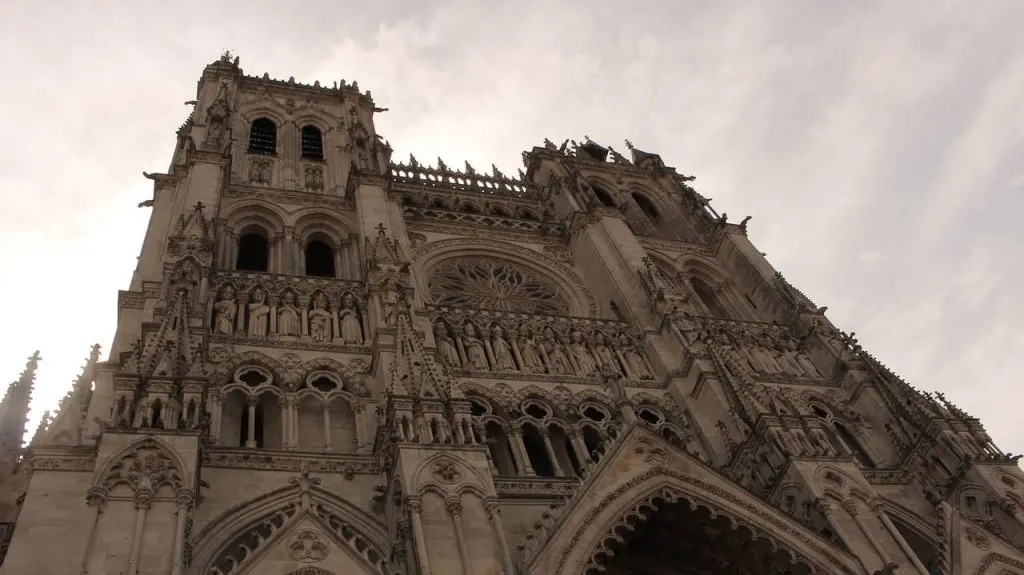
Arles, Roman and Romanesque Monuments
Arles is one of the most important historical cities in Southern France. This charming town on the banks of the Rhône River is one of the unmissable stops on a trip to Provence.
Arles was added to the UNESCO Heritage Site list several decades ago because of the antique ruins that have been preserved from the time when Arelate was the main city of the Roman province of Gallia Narbonensis. As a result, Arles is an excellent example of the adaptation of an ancient city to the needs of a medieval European civilization. This picture-perfect Southern French town also inspired many of Van Gogh’s paintings during the time when the Dutch painter lived here for a while.
The main monument from the Roman period is the Amphitheater that was cut directly from the rock in the 1stcentury B.C., and the gladiator fights were watched by more than 20,000 spectators in this large arena. The arena was used as a fortress in the Middle Ages with a couple of hundred buildings constructed in the interior, but later it was retransformed again to a Roman amphitheater to organize bullfights in it.
You can also visit the Roman Theater, built under Augustus about a hundred years later than the Amphitheater. Although the theater, the capacity of which is around 12.000 spectators, is quite deteriorated, it still testifies about the glorious times of the Roman Empire.
There are some other monuments left from the Roman era, such as the Baths of Constantine from the 4th century, the Cryptoportico of the Roman Forum, or the Tour des Morgues, a fortified tower from the 1st century. Some of the Romanesque buildings are also included in the UNESCO World Heritage Site, such as the Church of St. Trophime and its fascinating cloister.
Explored by Gábor Kovács from Surfing the Planet
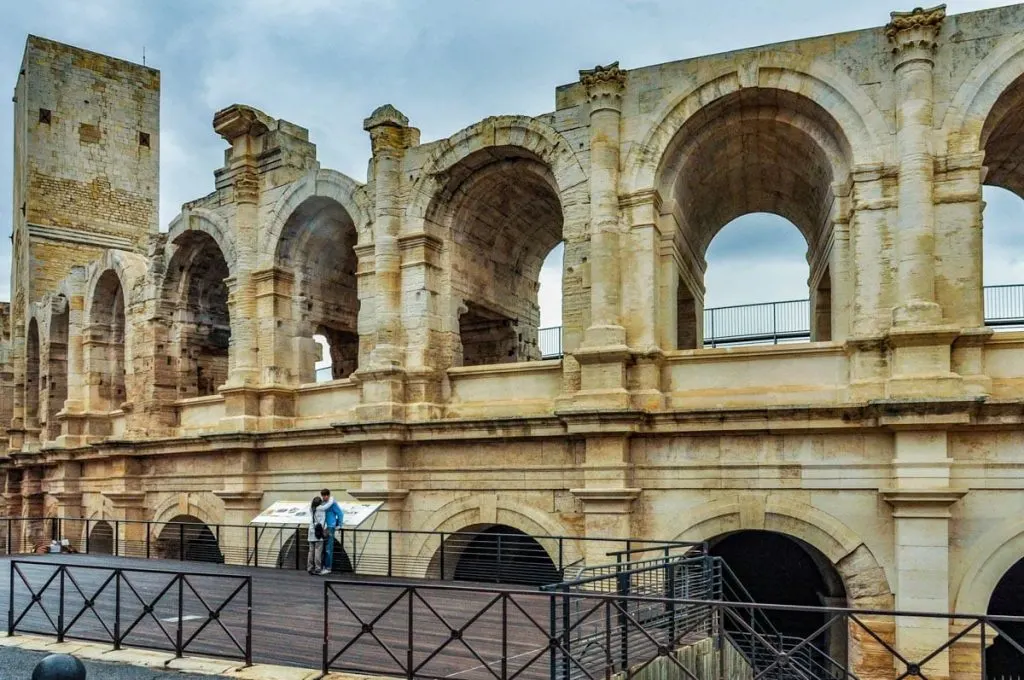
Belfries of Belgium and France
A total of 23 French towers form part of the Belfries of Belgium and France transnational UNESCO World Heritage Site. The buildings are located in municipalities across the north-east of France, including Calais, Lille, and Dunkirk.
Lille, a gateway to the region, is a little over an hour away from Paris on a high-speed TGV train and around three hours from London on the Eurostar. The belfries were inscribed by UNESCO because they are symbolic of the development of urban power during the Middle Ages. These are neither church towers, nor castle keeps. Some, though, look have the look of fortified towers; the one at Béthune is a free-standing structure dominating the market square.
Others, such as the belfry at Armentières, form an integral part of the town hall. The diversity of the belfries makes them fascinating places to explore for travelers interested in history and architecture. Climbing them means being able to look out over their respective towns and cities and enjoy outstanding perspectives.
I particularly enjoyed climbing the belfry in Arras, which rises over the Place des Héros, one of the cobbled squares in the heart of the city two-and-a-half hours’ drive north-east of Paris. The original 16th-century tower was destroyed by German artillery in World War One. The landmark was faithfully reconstructed. The effort that took indicates the importance of the belfry in Arras’s municipal identity and the desire of its citizens to see their city restored following its destruction.
From the belfry’s observation platform, it’s possible to look out onto the city’s rooftops and countryside that saw some of the First World War’s bitterest fighting.
Explored by Stuart Forster from Go Eat Do
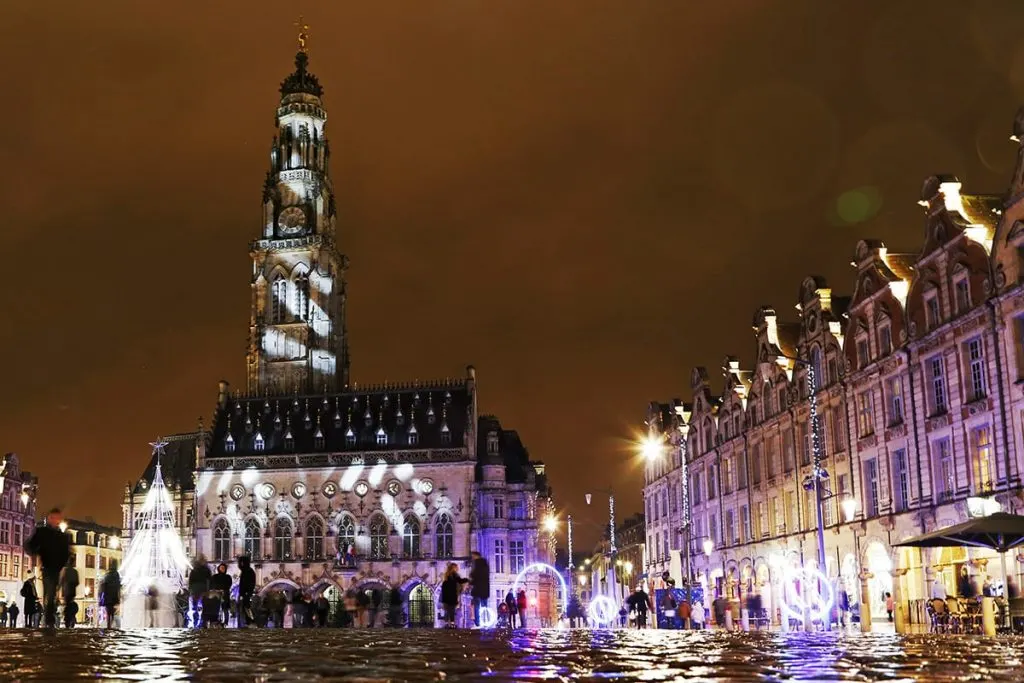
Bordeaux, Port of the Moon
Bordeaux is inscribed on the UNESCO World Heritage List under the title “Bordeaux, Port of the Moon.” Both the city and the greater Bordeaux region have been producing wine since the ancient Romans brought the tradition here over two thousand years ago.
During the middle ages, this city was the chief trading port for the export of French wine to England, and thus it was the major international city in the area. Today the city has seen a resurgence, in part due to its push to be inscribed on the UNESCO list, which it achieved in 2007. In addition to cleaning up the smog and dirt on the city’s architecture, they built the Cite du Vin, a major wine museum, and revitalized the main markets in the city.
Today Bordeaux is a sophisticated city to visit, and you would have no idea how much work went into getting it into such a pristine condition. From Bordeaux, you can visit wine chateaus in the area for wine tastings. Make sure to book ahead of time, as tastings and tours sell out early. During the day, you can also go on a city tour to learn about the history of the city as well as its important architectural sites and landmarks.
At night, take advantage of the fabulous food scene here. Make sure to ask your server for wine pairing recommendations. There’s no city on Earth where the waitstaff is more prepared and knowledgable about what you should drink during your meal!
Explored by Stephanie Craig from History Fangirl
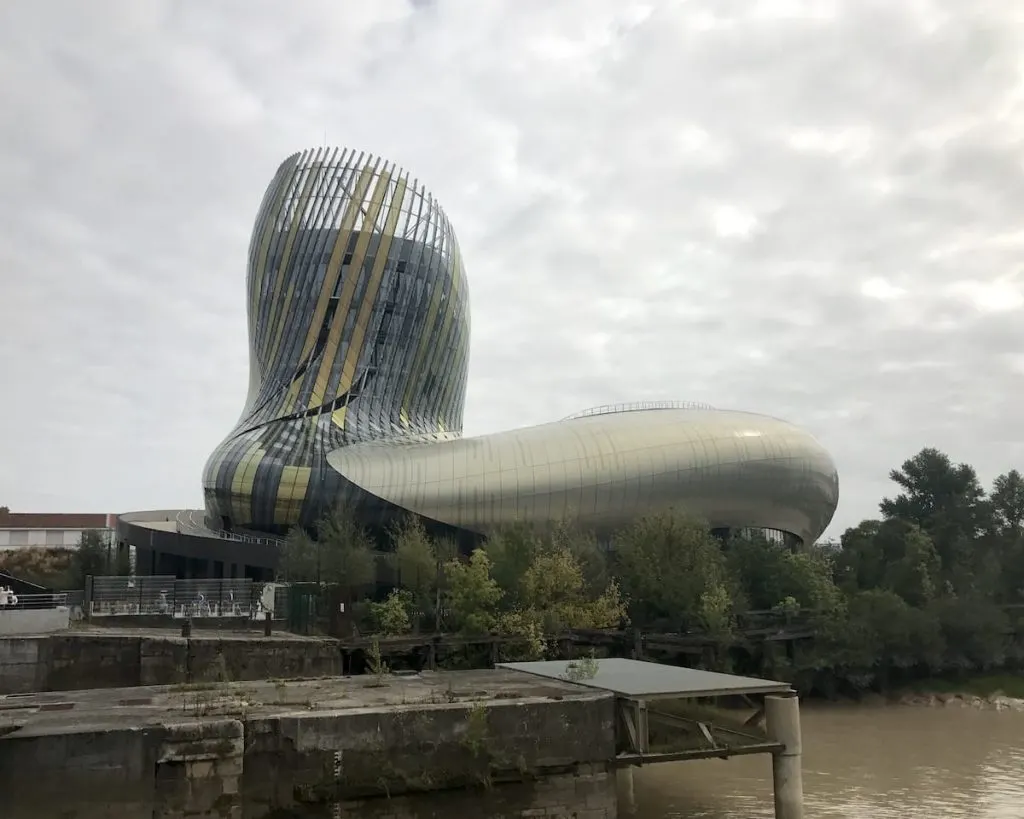
Bourges Cathedral
Located in a charming medieval town, Bourges Cathedral was designated a UNESCO World Heritage site in 1992. The cathedral was inscribed as an outstanding example of Gothic and Romanesque architecture.
Inspired by Notre-Dome-de-Paris, Bourges Cathedral is known for its symmetrical proportions, together with its stained glass windows. Work started on the cathedral in 1195. It was completed around 1230 and dedicated to Saint Stephen. There are 183 stained glass windows, some of which date from 1215. The Annunciation Window in the Chapel of Jacques Coeur is the best known.
The crypt is one of the largest in France. It contains the tomb of Jean 1st, Duke of Berry. Surprisingly, the crypt isn’t underground and is quite light. Underneath the crypt, there was originally a Romanesque church where the archbishops of Bourges were buried. What we love about the cathedral is the builder’s sense of fun. On the cathedral facade, the builders included a sculpture of buttocks hidden amongst a decorative frieze.
From Bourges Cathedral Tower, you have panoramic views over the town. Although there are actually two towers, the North Tower is the only one open to the public. It’s worth climbing the 396 steps to the top, as you can see for miles. Visiting the cathedral is one of the top things to do in Bourges. It is located on Place Etienne Dolet in the center of Bourges.
You can reach Bourges by train from Paris in two hours, or fly to the airport at Tours Val de Loire. From there, it’s around 1 hour and 45 minutes’ drive to Bourges.
Explored by Suze and Paul from Luxury Columnist
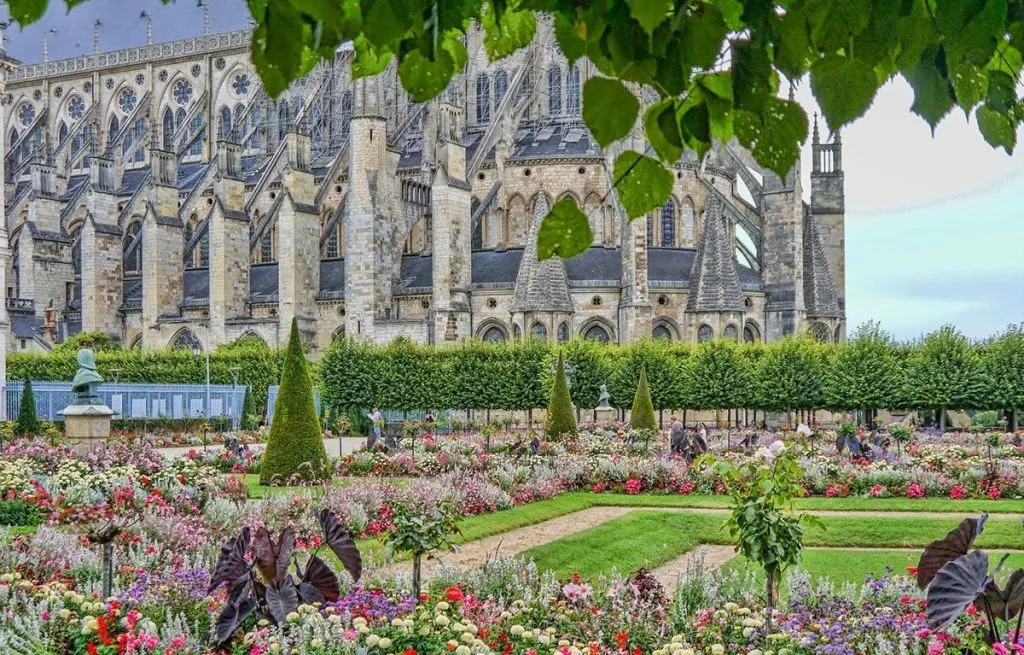
Canal du Midi
The 17th-century canal connects the Atlantic Ocean with the Mediterranean near Narbonne and Sète and is a feat recognized in its cultural status. Canal du Midi stretches up to 241 kilometers in length along Southern France through ancient villages, Roman fortifications, and famed vineyards.
The 240km-long waterway is a cultural site included on the list of UNESCO sites in France defined by its beauty. With huge plane trees that tower above both banks, their leafy branches often touch to form an arc of green above the water from bank to bank. The Canal du Midi was a remarkable engineering achievement when it was finished in 1681.
Sponsored by an engineer and canal-builder Pierre-Paul Riquet, he blended the Canal Royal du Languedoc (later to be renamed the Canal du Midi) so beautifully into the surrounding landscape. However, there were difficulties in supplying water to the highest point of the canal, which stood at 189 meters above sea level. Many doubters told Riquet that the canal would not have sufficient water to operate, but he decided to capture the waters of the Black Mountains and bring them to the threshold of Naurouze.
Riquet created the Bassin de Saint-Ferréol, followed by a channel that carried the waters to the threshold. In time, due to this water reserve tending to dry up, the shared reach was increased and flanked by the two famous locks that are named after the Atlantic Ocean and the Mediterranean Sea.
This is a great place for cycling, walking, or explore the towpaths running parallel to the canal. If you don’t feel like working out, simply watch the scenery pass by as you relax on the deck and sip on a cold drink. On a clear day, you can see the Pyrenees far away in the distance, whereas closer to hand is more than a thousand acres of wine grapes and the vineyards that stretch as far as the eye can see.
Explored by Ivan From Mind The Travel
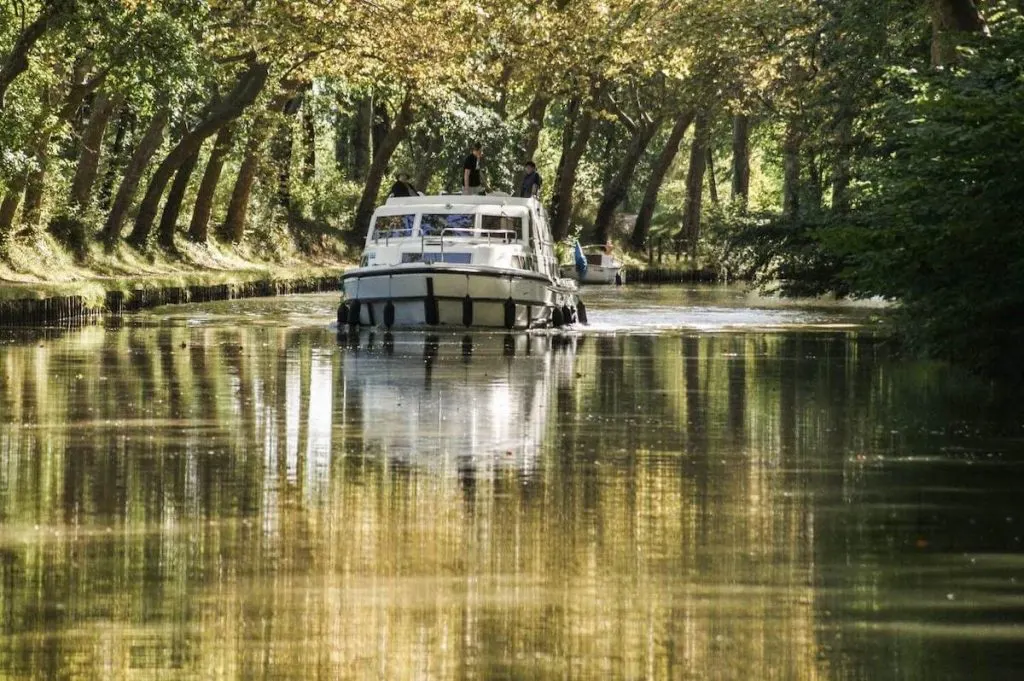
Cathedral of Notre-Dame, Former Abbey of Saint-Rémi and Palace of Tau, Reims
France is teeming with UNESCO World Heritage Sites, and one of the most impressive that I have visited was the Reims Cathedral, or Notre-Dame de Reims in French. While many people head to the city to take a Champagne tour from Reims, there are so many other impressive things to do in the city, such as visit this historic religious icon despite its location in the heart of Champagne country.
The Notre-Dame de Reims is a church dedicated to the Virgin Mary, and the reason it is so renowned is that it served as the coronation location for the past kings of France. Over one million people annually visit the famous sight, and you can go in independently or as part of a tour when visiting Reims.
The Cathedral dates back to the 5th-century and was allegedly founded by Bishop Saint Nicasius. Reims Cathedral, at least what you will view today, dates back to the 13th-century when the construction began (and ended in the 15th-century). It is noted to be a very prime example of High Gothic architecture that was initially built to replace a church that was destroyed in a 1221 fire.
Needless to say, WW1 had its impact on the church, causing major damages to it. It was restored once again at the beginning of the 20th-century. The Reims Cathedral, along with other city sites such as the former Abbey of Saint-Remi and the Palace of Tau, was added to UNESCO’s list in 1991.
Visiting the Reims Cathedral is easy if you’re in Reims, a fantastic weekend break in France. The church is in the middle of the city and located near all of the other famous attractions. The best way to visit the cathedral is on a free guided tour with the Reims City Card– you will have the chance to gain knowledge about the landmark while marveling at its impressive and ornate details.
Explored by Megan from Meganstarr.com
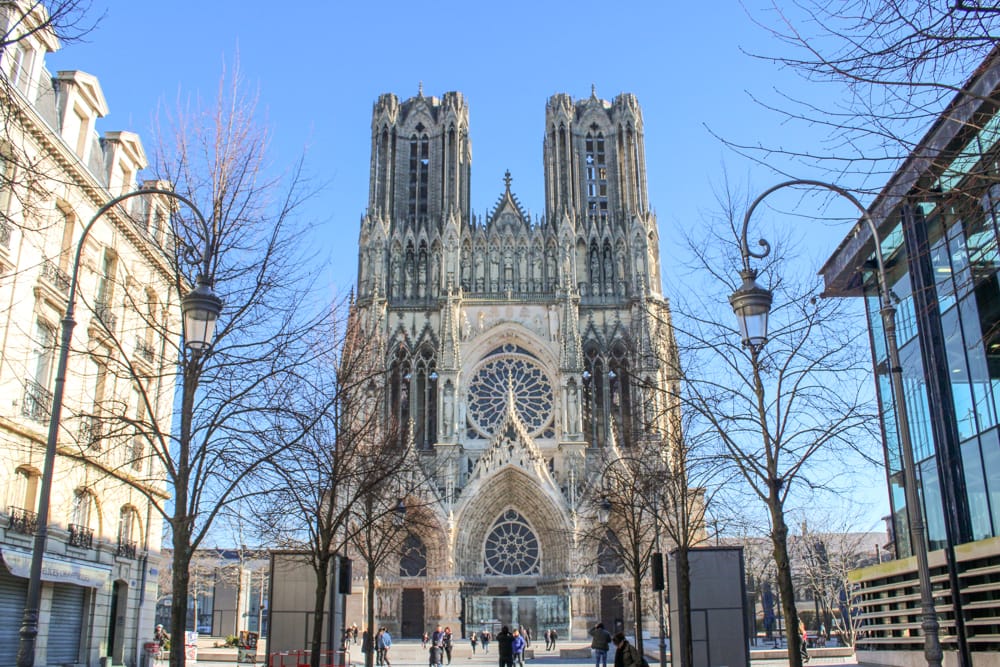
Champagne Hillsides, Houses and Cellars
The Champagne Hillsides, Houses, and Cellars site is arguably one of the tastiest UNESCO World Heritage Sites in Europe. But why is the Champagne region a UNESCO Site? Mainly because it is one of the most iconic beverages that can look back on centuries of history and longstanding traditions that are extremely influential to this region and beyond. The Champagne and most of its residents live for this drink. They are either involved in the production, selling or promoting of Champagne or know someone who is.
The Champagne UNESCO Site actually consists of 3 locations: the historic vineyards of Hautvillers, Aÿ and Mareuil-sur-Aÿ, the Saint-Nicaise Hill in Reims, and finally the Avenue de Champagne and Fort Chabrol in Epernay. Each of the three locations focuses on a step in the Champagne production process: Growing the grapes on the lush hillsides, producing the champagne and aging it in the Cellars, and at last, distributing it all over the world through the famous Champagne Houses.
If you are a fan of the bubbly drink, I highly recommend you plan a visit there. You will get to learn about the Champagne making process, can visit some of the most iconic Champagne Houses like Mumm & Co, Moët et Chandon, and Perrier-Jouët, and of course, taste your way through various Champagne tastings. The epicenter of the Champagne region is Epernay, where you can wander along the Avenue de Champagne. This street is home to the Who-is-Who of Champagne making and after the Champs-Elysee the most expensive address in France.
Visiting the Champagne is not just educational, but also a very tasty endeavor.
Explored by Maria Haase from EuropeUpClose.com

Chartres Cathedral
A masterpieces of the French gothic style about 80 km southwest of Paris, the Chartres Cathedral’s construction started in 1145. It wasn’t finished before a fire destroyed in 1194, after which its reconstruction started and took 25 years.
The Cathedral denotes the high point of French Gothic art and is quite the sight to behold. The expansive yet ornate nave, the porches decorated with exquisite sculptures from the 12th century, and the exalted 13th-century stained-glass windows, all in exceptional condition, consolidate its appeal.
It is protected by UNESCO as one of the most genuine and complete works of religious architecture of the era. Dedicated to the Virgin Mary, it was among the most popular pilgrimage destinations in all medieval Western Christianity.
This Cathedral is free to visit and utterly spellbinding.
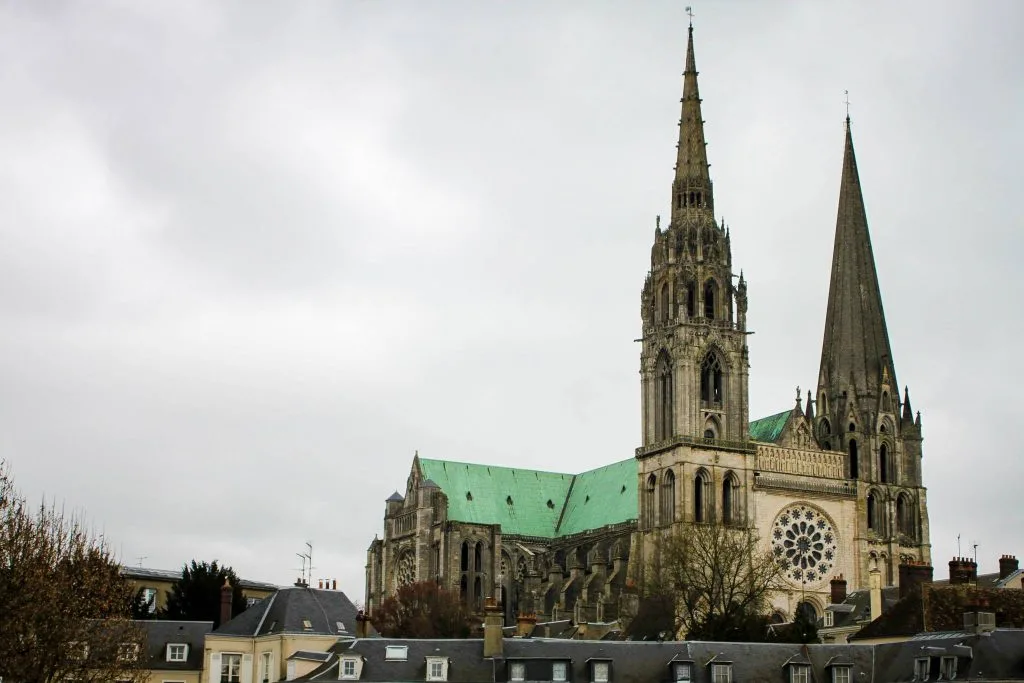
Cistercian Abbey of Fontenay
Fontenay Abbey is a former Cistercian abbey located in the Burgundy region of France that was home to monks from the 12th century until well into the 18th century when major dechristianization during the French Revolution led to all of the monks leaving the abbey.
The site was then transformed into a paper mill that ran for a number of years before being brought and restored by a private owner, Edouard Aynard in the 1900s.
In 1981 the abbey became a UNESCO World Heritage Site due to it being located in a valley remarkable beauty as well as the fact that it is the oldest preserved Cistercian abbey in the world. This heritage status allowed visitors the chance to explore this wonderful site, soaking up the atmosphere of the abbey. The complex comprises a Romanesque church, cloisters and chapter house, sleeping quarters, bakery and ironworks, and pretty much the only feature that is lacking from the original design is the refectory that was destroyed in 1745.
Guests can enjoy a guided tour of the monastery buildings, the manicured gardens, the lapidary museum, and the library learning about the history of the buildings as well as gaining an insight into the lives of the monks who resided here.
Fontenay Abbey is situated between Auxerre and Dijon in the east of France and can be easily reached from either city in just over an hour (by car). Alternatively, visitors can travel to the area by train, with journeys taking around 1h40 from Lyon and 2h15 Paris (on the fastest routes).
Explored by Chrysoula from Historic European Castles
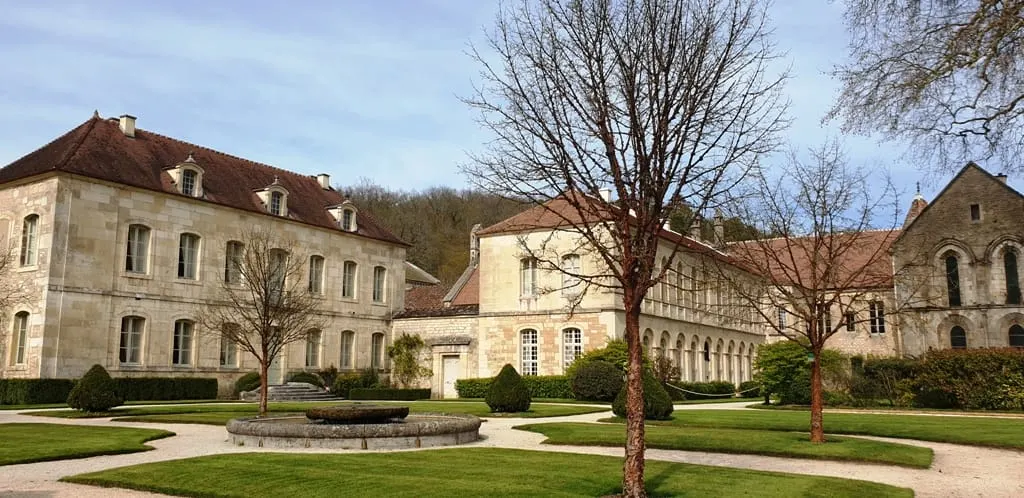
Decorated Cave of Pont d’Arc, known as Grotte Chauvet-Pont d’Arc, Ardèche
Discovered inside a limestone plateau of the Ardèche River in southern France, the world heritage site protects the world’s earliest-known and best-preserved figurative drawings. Dating back to around 30,000 years ago, the site is an outstanding testimony of prehistoric art and significantly increased our understanding of human development.
Rather fortuitously for us today, the cave was sealed off by an apparent rockfall around 20,000 years ago. The site remained closed until its recent discovery in 1994. This ensured the cave’s pristine situation. More than 1,000 images have been reviewed on its walls, with a diversity of both anthropomorphic and animal subjects. Of excellent aesthetic quality, the paints express a spectrum of different techniques, including the accomplished use of shading, blends of paint and engraving, anatomical accuracy, three-dimensionality, and movement.
Interestingly, they also depict several dangerous animal species that would have been extremely challenging to observe, such as mammoth, bear, cave lion, rhino, bison, and auroch. Within the caves were also found over 4,000 remains of prehistoric fauna and human footprints.
Given the incredibly well-preserved condition of the site, it is easy to understand why access is severely restricted. So unless you are a researcher with impeccable credentials (and even then), you will not be able to visit the Pont-d’Arc Cavern. A replica cave, however, has been set up just a few miles from the original.
Episcopal City of Albi
The beautiful Episcopal City of Albi in southern France was declared a UNESCO World Heritage Site in 2010 and boasts numerous must-see architectural sites. Consisting of four medieval districts, largely built from red-hued bricks, two of the Episcopal City’s buildings dominate the skyline.
Thought to be the largest brick building in the world, Cathedral Ste-Cecile began life back in the 13th Century as a fortress to protect against invading crusaders. Even today, this imposing place of worship, with its 78-meter tall bell tower, oozes importance. It may have a somewhat austere exterior but the interior of the Cathedral is a sight to behold. Featuring stunning stained glass windows, hand-sculpted wooden carvings and vaulted ceilings, it’s hard not to be impressed.
Next to the Cathedral, the Berbie Palace is another UNESCO site. This Bishops Palace, which also dates back to the 13th Century, is considered to be one of the best-preserved episcopal palaces in France. Whilst the bishops no longer reside here, both the Tourist Office and the Toulouse-Lautrec Museum – which holds the most complete collection of the artist’s work in the world – are housed in the Berbie Palace.
Adjoining the Palace, and offering superb views of the Tarn River below, are the Palace Gardens. These formal gardens, which are based on the style of the gardens at Versailles (although on a smaller scale), can be viewed from a walkway on the old palace ramparts.
Spanning the River Tarn below the Berbie Palace Gardens is the Pont Vieux (old bridge), dating back to 1040. One of the most-photographed sites in Albi, the eight-arched bridge originally featured drawbridges at each end to stop invaders, before it became a toll road in the 12th century as commerce increased between the Mediterranean Sea and the Atlantic Ocean. For wonderful views of the Pont Vieux and the Episcopal City, cross the bridge and follow the signs to Pont Vue, a designated viewing area.
Albi is located in the Tarn department of southern France. It is 76 kilometers northeast of Toulouse and can be reached by car in around one hour and by train in 90 minutes.
Explored by Carolyn of Holidays to Europe
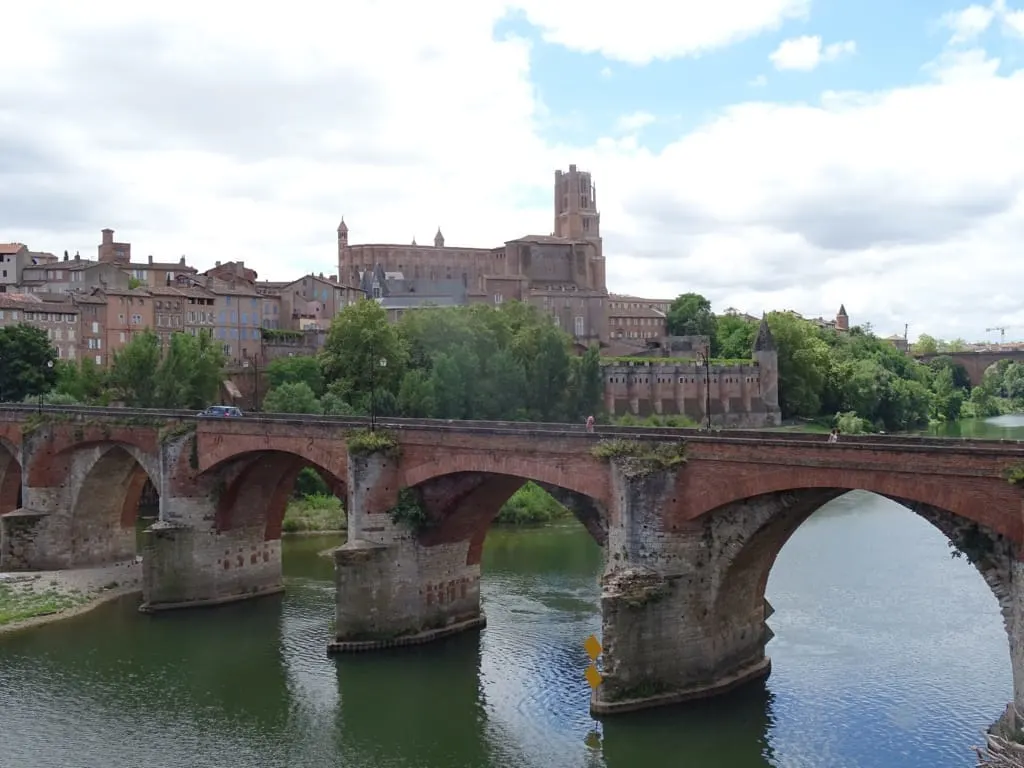
Fortifications of Vauban
Sébastien Le Prestre de Vauban: military engineer, advisor to Roi Soleil Louis XIV, France’s most famous king, and builder of forts, 12 of which have found their place on UNESCO’s World Heritage list. In Aquitaine in southwestern France, the kids and I visited Citadel de Blaye and Fort Médoc, two of Vauban’s constructions.
On the right bank of the Gironde estuary is Citadel de Blaye, on the left is Fort Médoc. And as if those two weren’t enough, our engineer also built Fort Paté on an island. Together, the fortifications closed off the river and protected the city of Bordeaux, 50 km upstream, from enemy ships.
The three are known as Le verroux de l’estuaire (Bolt of the estuary) or Vauban’s trilogy. Blaye is located on a rocky headland, with impressive views all round. It is a well-preserved citadel, and the old barracks now serve as workshops for artists and craftsmen. There are restaurants and a hotel, as well as a museum showing the history of the area; a cozy, colorful place to stroll, with interesting handicrafts on offer.
Across the river, in Cussac-Fort-Médoc, square-shaped Fort Médoc was empty when we visited on a hot July day, and as such a place to let the imagination (and the kids) run free. The views are great from this side, too, especially from the high point by the Guardroom.
Fort Médoc is surrounded by a wooded area, good for walks. Or maybe a picnic on these historic grounds? Driving/cycling up here, you’re on one of Bordeaux’ many wine routes. Fort Paté on the island is off-limits. Private property. But you can sail past; a car ferry connects the two banks of the Gironde. It is also possible to take a 2-hour guided cruise that takes in the underground passages of the citadel.
Explored by Anne-Sophie Redisch from Sophie’s World
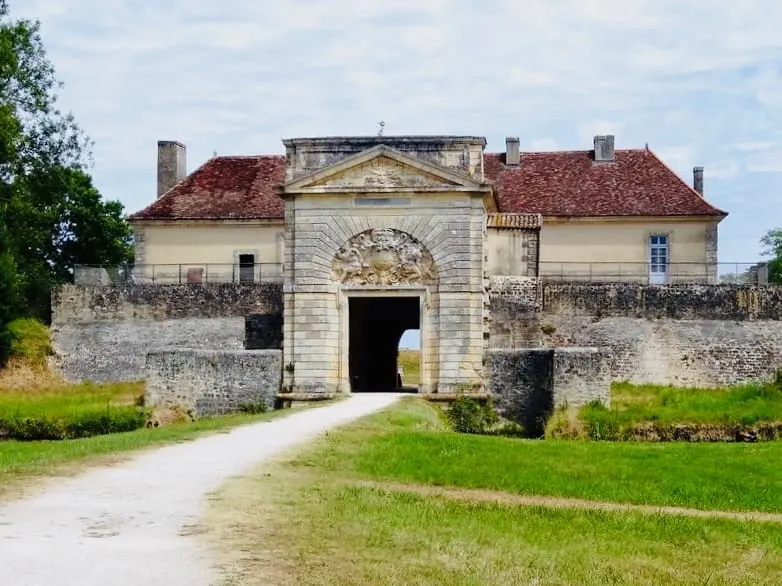
From the Great Saltworks of Salins-les-Bains to the Royal Saltworks of Arc-et-Senans, the Production of Open-pan Salt
The Saline Royale (Royal Saltworks) is a classical building at Arc-et-Senans in eastern France, on the edge of the Forest of Chaux. Built by famous Parisian architect Claude-Nicolas Ledoux in 1775, the Royal Saltworks was the first significant success of industrial architecture, echoing the Enlightenment ideals.
The large, semicircular complex was intended to sanction a logical and hierarchical organization of work and be the first step in constructing an ideal city, a scheme that never materialized.
The nearby Great Saltworks of Salins-les-Bains ran for over 1200 years (until it closed in 1962), and including an underground gallery, hydraulic pump, and boiler room from different eras. Between 1780 to 1895, the saltwater from this site ran through 21 kilometers of wood pipes to the newly constructed Royal Saltworks of Arc-et-Senans (the saltworks being built near the immense Chaux Forest to secure its stocks of wood for fuel).
Taken together, the saltworks in Salins-les-Bains and Arc-et-Senans demonstrate exceptional universal value in showcasing the various means of extraction of salt from the Middle Ages, and probably from prehistoric times, through to the 20th century.
Today spa activity uses the area’s salt, but no mining takes place. The site is largely open to the public, and the Royal Saltworks has displays of futuristic projects that were never built and temporary exhibitions. If you travel along the train line from Besançon to Bourg-en-Bresse, you can stop at the station for Arc-et-Senans for a quick look. You’ll only need around an hour.
Historic Centre of Avignon: Papal Palace, Episcopal Ensemble and Avignon Bridge
In southwest France’s Provence-Alpes-Côte d’Azur region, the city of Avignon has been recognized by UNESCO for the group of 14th-century buildings that lie right at its heart – the Historic Centre of Avignon: Papal Palace, Episcopal Ensemble and Avignon Bridge.
In 1309, Avignon became the seat of the Papacy after the Catholic Church decided to escape the corruption which was engulfing Rome. So they set up a new base in Avignon where they stayed for the next 68 years, leaving their mark on the city with a selection of impressive monuments.
The Palais des Papes (Pope’s Palace) is the biggest Gothic palace in the world, covering 15,000 square meters. Inside you can see some of the ornately painted original décor, with 25 rooms open to visitors. The palace also hosts a sound and light show on summer evenings – and has a rooftop terrace with one of the best views over Avignon.
The palace is just the start though – in the square are the Petit Palais museum of medieval art, the Basilica of Notre Dame des Doms with its golden statue of the Virgin Mary, and the Baroque building which housed the city Mint.
But most famous of all is the Saint Bénézet Bridge over the River Rhône – better known as the Pont d’Avignon. Only four of the bridge’s original 22 arches are still standing so you can’t cross the river on it, but it’s become a French icon thanks to a 15th-century children’s song about dancing ‘Sur le Pont d’Avignon’.
Take a walk along the opposite bank of the Rhône for the best views, with the bridge in front and the pale stone buildings of the palace behind on the Rocher des Doms – especially beautiful at sunset when they take on a golden glow.
Explored by Lucy from On the Luce
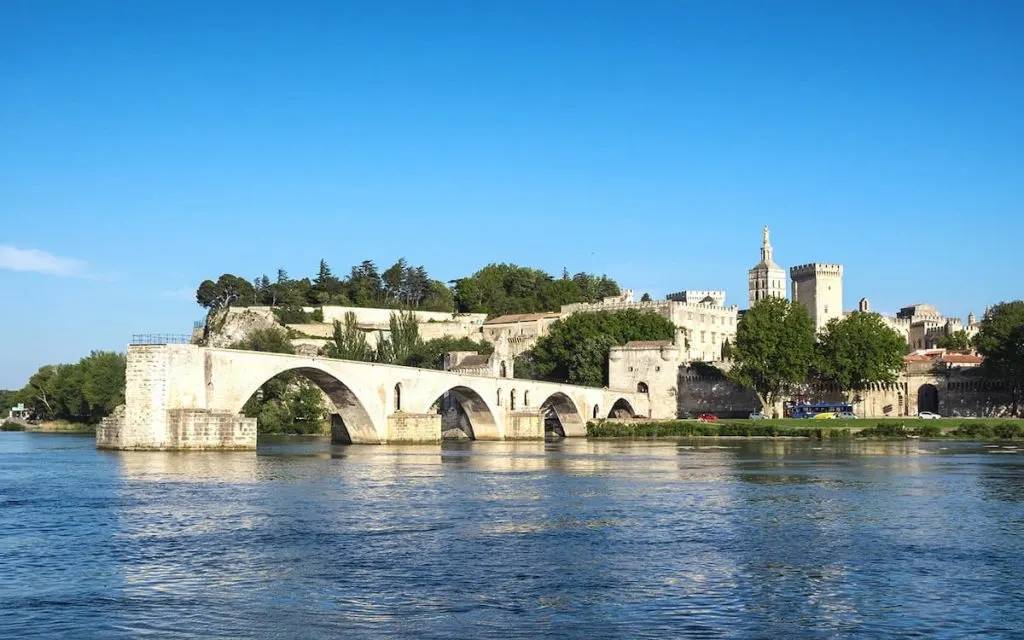
Historic Fortified City of Carcassonne
The historic fortified city of Carcassonne is an extremely well-preserved medieval complex located in the Languedoc region of southern France. Perched on a hilltop and surrounded by a large wall, it truly is a breathtaking sight.
Due to the pristine condition of the town and its beautiful historic buildings which include a Gothic Cathedral and a beautiful 12th-century castle, called Chateau Comtal, the city Carcassonne became inscribed as a UNESCO World Heritage Site in 1997. The other reason it was recognized by UNESCO was because of the extensive restorative work that was completed in the 19th century on the town’s castle, walls, and church.
My personal highlight of visiting Carcassonne was the feeling of being transported to another time period. As you walk through the entrance gate and into the cobbled streets of the town center, you immediately feel like you’ve stepped back in time a few hundred years. Exploring Chateau Comtal and walking along the town’s fortifications will give you a different perspective of the town and also see the incredible views over the surrounding countryside.
Getting to Carcassonne is easy to do as there is an airport that is easily accessible from most major cities in Europe. If you are already driving around France with a car, Carcassonne makes the perfect addition to any south of France road trip itinerary. It’s located one hour away from Toulouse by car or just under two hour’s drive from Montpellier.
Explored by Ann from The Road Is Life
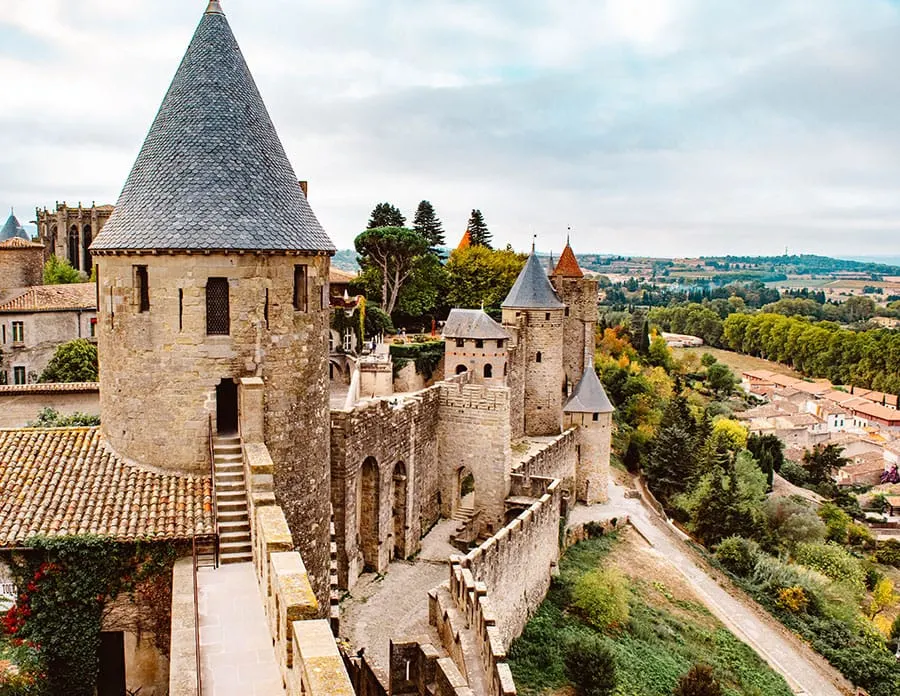
Historic Site of Lyon
It’s not hard to see why Lyon is a World Heritage Site. Of course, it has plenty of beauty and art and extraordinary architecture but what is most striking about France’s second-largest city is its historical diversity: the city dates back 2000 years, but as it expanded, each period took over a neighborhood. As a result, you’ll be able to retrace the city’s history through the four areas covered by UNESCO’s list.
The first of these is Fourvière, the hill which once hosted Lugdunum, the Roman capital of the Gauls. It is home to some outstanding Roman theaters as well as the city’s Basilica. Not to be neglected is the view down the hill into Lyon – the best in the city.
The second protected part of town is Old Lyon, whose cobblestones and tiny passageways, known as traboules, linked the city’s hills. A wander through the traboules is a highlight of a Lyon visit.
The next on our list is the Croix-Rousse, once home to 30,000 silk workers, called canuts. The taller windows on the upper floors of certain buildings are reminders of the weaving looms that were once housed there. While most of the canuts are gone, the silk industry is remembered through a museum, workshops and many fashionable boutiques.
The Presqu’ile is our final stop, whose grandiose squares and buildings remind us instantly that we are in France. This is also where you’ll find many of Lyon’s most famous murals, often soaring creations whose minute realism is delightful.
Getting to Lyon is a simple matter, with regular TGV trains running from Paris, several trains a day from Geneva, and an international airport. If you’re driving from Paris to Provence, it’s the perfect halfway stop – Lyon is also known as France’s gastronomical capital and a worthy lunch experience.
Explored by Leyla Giray Alyanak of Offbeat France
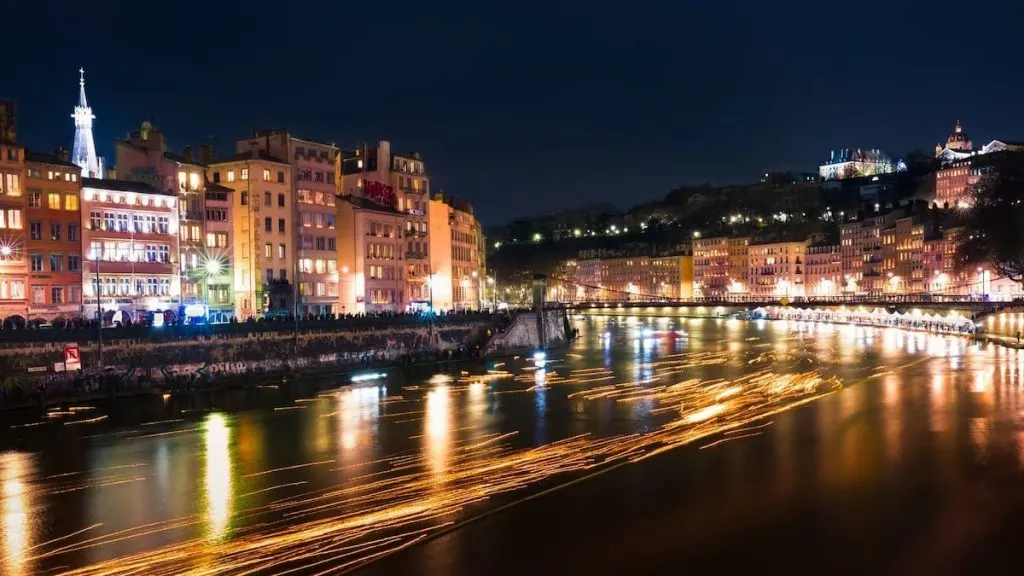
Jurisdiction of Saint-Emilion
Saint-Émilion, a medieval village with a history stretching across 13 centuries, is a doubly special UNESCO World Heritage Site. Located just 1 hour from Bordeaux in the South West of France, it’s not only the charming fortified village itself that was inscribed as UNESCO site. As a cultural landscape with roots of winemaking dating back to Roman times, the vineyards themselves were also the first-ever to be inscribed into UNESCO when the Jurisdiction of Saint-Émilion won this distinguishment in 1999.
Usually a day tour for visitors from Bordeaux, Saint-Émilion deserves far more than the few hours to explore. The village itself was impressively carved out of the limestone promontory it’s perched upon. Like a bowl, the gates to the fortifications surrounding the village quickly drop down steep tertres (ancient streets) and deliver visitors to a charming labyrinth of shops and sights.
If there’s one must-see, it’s the 12th-century Monolithic Church. The name literally means carved out of a single stone and the underground church is the largest of its kind in Europe. Only accessible on a guided tour through the Saint-Émilion tourism office, it’s well worth the visit to see this impressive church with its well-preserved murals and its catacombs.
Of course, Saint-Émilion is famous for its wine and you can’t leave without a visit to one of the more than 1000 surrounding wineries. There’s a variety of ways to visit the various nearby châteaux from tuk-tuk tours to regal castles just a short walk outside the village.
There’s even a former convent located within the walls of Saint-Émilion where AOC Crémant de Bordeaux is aged in the maze of underground quarry tunnels that once served the purpose of quarrying the limestone used to build the facades of châteaux, the 18th-century Neo-classical buildings of nearby Bordeaux and the intricately carved facades of Saint-Émilion.
Explored by Jennifer & Tim from The Bordeaux Travel Guide

